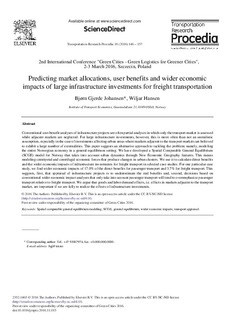| dc.contributor.author | Johansen, Bjørn Gjerde | |
| dc.contributor.author | Hansen, Wiljar | |
| dc.date.accessioned | 2019-06-26T13:03:30Z | |
| dc.date.available | 2019-06-26T13:03:30Z | |
| dc.date.created | 2017-02-17T10:48:56Z | |
| dc.date.issued | 2016-11-23 | |
| dc.identifier.citation | Transportation Research Procedia. 2016, 16, 146-157. | nb_NO |
| dc.identifier.issn | 2352-1465 | |
| dc.identifier.uri | http://hdl.handle.net/11250/2602348 | |
| dc.description.abstract | Conventional cost-benefit analyses of infrastructure projects are often partial analyses in which only the transport market is assessed while adjacent markets are neglected. For large infrastructure investments, however, this is more often than not an unrealistic assumption, especially in the case of investments affecting urban areas where markets adjacent to the transport markets are believed to exhibit a large number of externalities. This paper suggests an alternative approach to tackling the problem; namely, modeling the entire Norwegian economy in a general equilibrium setting. We have developed a Spatial Computable General Equilibrium (SCGE) model for Norway that takes into account urban dynamics through New Economic Geography features. This means modeling centripetal and centrifugal economic forces that produce changes in urban clusters. We use it to calculate direct benefits and the wider economic impacts of infrastructure investments for freight transport in selected case studies. For one particular case study, we find wider economic impacts of 17.0% of the direct benefits for passenger transport and 3.7% for freight transport. This suggests, first, that appraisal of infrastructure projects is to underestimate the real benefits and, second, decisions based on conventional wider economic impact analyses that only take into account passenger transport will tend to overemphasize passenger transport relative to freight transport. We argue that goods and labor demand effects, i.e. effects in markets adjacent to the transport market, are important if we are fully to realize the effects of infrastructure investments. | nb_NO |
| dc.language.iso | eng | nb_NO |
| dc.publisher | Elsevier | nb_NO |
| dc.rights | Attribution-NonCommercial-NoDerivatives 4.0 Internasjonal | * |
| dc.rights.uri | http://creativecommons.org/licenses/by-nc-nd/4.0/deed.no | * |
| dc.title | Predicting market allocations, user benefits and wider economic impacts of large infrastructure investments for freight transportation | nb_NO |
| dc.title.alternative | Predicting market allocations, user benefits and wider economic impacts of large infrastructure investments for freight transportation | nb_NO |
| dc.type | Journal article | nb_NO |
| dc.type | Peer reviewed | nb_NO |
| dc.rights.holder | © 2016 The Authors. Published by Elsevier B.V. | nb_NO |
| dc.description.version | publishedVersion | nb_NO |
| cristin.unitcode | 7482,3,3,0 | |
| cristin.unitname | Næringslivets transportbehov | |
| cristin.ispublished | true | |
| cristin.fulltext | original | |
| cristin.qualitycode | 1 | |
| dc.identifier.doi | 10.1016/j.trpro.2016.11.015 | |
| dc.identifier.cristin | 1451570 | |
| dc.source.journal | Transportation Research Procedia | nb_NO |
| dc.source.volume | 16 | nb_NO |
| dc.source.pagenumber | 146-157 | nb_NO |

